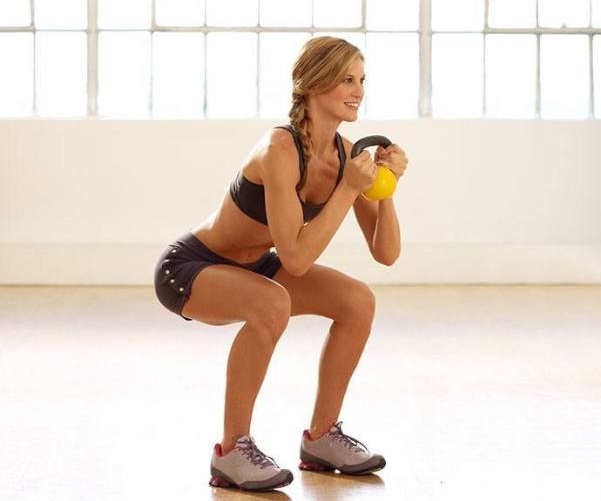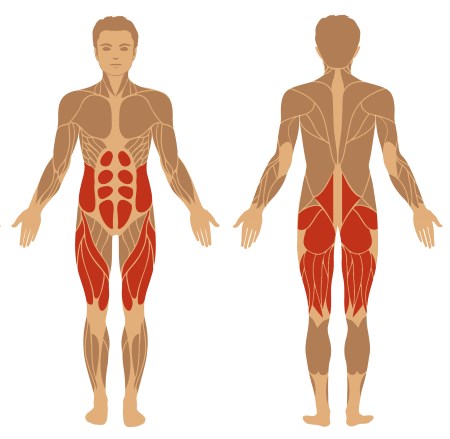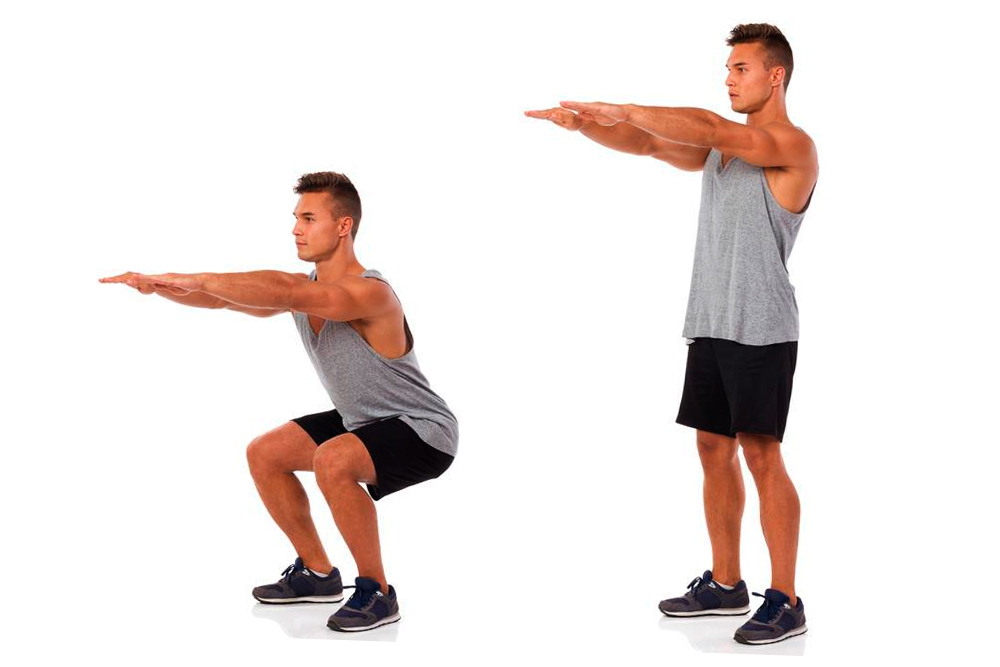Squats – 5 rules how to do squats correctly
If there is one exercise that should never be missed with good leg workouts, it is the squat. However, many find it difficult to do the right squats. The effectiveness of this difficult basic exercise depends, of course, on the correct version of the squat.
For this reason, I want to give you a few rules in this article that you should pay attention to if you want to do squats really well and effectively. With squatting techniques, you can pay attention to many little things and your form will never be 100% perfect. However, in my opinion, there are a few things that are extremely important for really good squats. If you keep this in mind, your performance will be much better quickly than most others in your gym. So that you don’t get lost in detail unnecessarily and can focus on the really important things, I’ve summarized these ground rules here.
Also, I’ll cover some of the basics you should know in this article. This includes, for example, why it makes sense to do squats, which muscles are primarily trained with it, and what possible alternative exercises.
I have divided the article into the following sections. With one click, you will be taken directly to the section that interests you the most.
After reading, you should know enough about squats to use them with a clear conscience and understand their benefits. I am sure that with a little practice, you will soon be able to do squats well.
Why you should squat regularly

When it comes to particularly effective strength training, squats, along with deadlifts and bench presses, are almost always cited as one of the first disciplines. Unsurprisingly, hardly any other strength exercise brings so many benefits to your workout and life.
This applies no matter where you are in your training. If you’re looking to build muscle and hypertrophy workouts, squats fit into your workout plan as well as strength endurance training. To find out why this is the case, I would like to summarize the most important reasons why you should have squats as your main exercise in your training plan.
1) Squats done correctly are very functional
The squat itself is a completely natural movement. Therefore, doing squats correctly will also be beneficial for your daily movement. You are strengthening your muscles in ways that are beneficial in a wide variety of sports and everyday situations. This also includes the increased performance of your heart that you acquire through such very difficult and strenuous exercises.
Contrary to popular belief, regular, properly performed squats free up your joints and don’t strain them. Plus, you will notice an increase in your mobility after a while. This, in turn, is also useful for a variety of daily activities.
2) Squats improve your balance and flexibility
Only deep squats are really well done squats. If you do squats correctly, the range of motion is very wide. This requires good mobility in the hip, knee and ankle joints. If you are not that flexible at this point, you will gradually train yourself to a very good squat form. As a result, your mobility increases in these joints. A positive side effect is that it often means that everyday complaints disappear, which you did not even know, due to limited mobility.
Many people don’t have a very good balance these days. Here, squats can help improve balance and overall body awareness. Due to the rather high weight position, the body weight must be supported under load. This is a real challenge for some beginners. But don’t worry, it will improve quickly and will also have a positive effect on your stability and how your body feels in your daily life. Of course, you don’t have this effect when you squat in multi press.
3) Squats are good for your health
Squats are rumored to be unhealthy. In fact, doing squats correctly is very beneficial to your health. It is not true that squats will break your knees and not damage other joints, cartilage, and tendons. Squats done right are good for your health and use all of these body structures.
Regular heavy squats especially strengthen bones and joints. Due to the pressure of the weight during movement, these structures are especially tense and compressed and are stimulated to adapt. In the case of bones, this leads to an increase in bone density and therefore stability. This, in turn, makes for ideal prevention of squat osteoporosis.
Through muscle building and training posture, good squatting technique also maintains healthy posture and helps withstand widespread postural damage and common hip and back problems. This, in turn, also has a positive effect on cause 4.
4) Squats make you strong and sexy
There is hardly a better exercise for strong legs and a good round bottom than the squat. Similar to the deadlift, energy consumption and growth hormone release due to high muscle tension are very high compared to other exercises. The result is a positive effect on metabolism and muscle growth. It is also very useful if you want to define your muscles and gain as much muscle mass as possible.
All of this means that for each strength training goal, you will reach your target figure faster and more efficiently by doing regular squats.
If these reasons have not convinced you to do regular squats in your strength training, then I cannot help you anymore.
What muscles are trained during squats
Squats are one of the most difficult basic exercises. This means that a large number of muscles are involved in the movement. The squat is probably the main exercise with the most overall muscle activation. In other words, the total load on all muscles is the highest. This is also due to the fact that muscles under severe stress are especially large.
I’m not going to go over all the muscles that play a role in stabilizing and supporting squats. The following muscles are prime targets for squatting:

Simply put, you squat, especially your hips, glutes, and core muscles. Those who would like to know a little more precisely are the following muscles:
- Anterior thigh muscles
- muscles of the back of the thigh (biceps of the leg, muscles of the semi tendon, muscles of the platinum tendon)
- gluteus and thigh muscles (especially gluteus maximus, median and minimus)
- back extensor (spinal muscle)
- abdominal muscles
These are basically the main squat muscles. In addition, some other muscles are also involved in the movement to support it. The calf muscles continue to make a significant contribution here. The upper body is also possible, as the weight on the neck must be stable. However, I think there is no question that the squat is a central exercise in leg workout because of the muscles it needs. It doesn’t matter if you follow a split workout plan or do a full body workout, you can’t do without this exercise.
5 rules you can use to do squats really well

Now we finally arrive at the squat version. There are many subtleties you can look at when doing squats to make them as effective and clean as possible. However, there is a risk of getting bogged down for a long time and dealing with things that have little impact on your training success. However, if you want to squat properly and do it quickly, there are some simple rules to watch out for.
I have noticed this with a lot of people, as well as other good coaches, where squatting mistakes are often made and can quickly lead to significant improvement. Next, I would like to briefly introduce you to the 5 most important rules of a good squat version. You will be able to significantly improve your squats very quickly.
Good Squats Rule 1: Find the Right Stance
The correct position in the squat is individual. How far apart your feet are and at what angle your feet and knees are optimally directed outward is largely individual. Of course, now I can tell you to be hip-width apart and bend your toes forward. However, I cannot say if this is truly optimal for you. To find the right position, you can simply try what you like best. Which position of the legs feels best, most loose in the hips and knees? It is best to start straight at the hip and slowly turn your legs outward. Make sure your knees always point towards the tips of your feet.
Squat Technique Rule 2: The trunk is the key
Similar to the deadlift, a straight back is essential for a clean and healthy performance. You must ensure that your core muscles are constantly under tension throughout the entire movement. This includes tension in the lower back as well as in the abdominal muscles. Make sure your back is in a balanced, neutral shape.
Good tension in the abdominal / torso muscles prevents common mistakes such as butt (hip overturning) or a strong hollow back. Both can lead to problems in the medium to long term. Many people train with a weight-lifting belt to maintain stability.
Squats Rule 3. Stable knees are healthy knees
Many participants clearly underestimate the importance of stable knees in squatting techniques. The title should already say that special attention should be paid here. You shouldn’t let your knees fall hard on the way up or down. Make sure your knees are pointing towards your toes. The knees point slightly further outward than inward. If your knees drop inward, you risk irritation and injury to your ankles and Achilles tendon. If you notice that your knees are collapsing, you can deliberately push your knees out slightly to counteract this
Squat Rule 4: Start Right in the Squat
The correct starting position often chooses between good and bad squats. To do this, lower the bar so that you can lift it from the rack without rising on tiptoe (approximately to chest height). Then lift the bar up on the upper trapezium (the major muscle of the neck) and hold it so tight that you can still comfortably hold the bar halfway, and pull your elbows back. You can start from this position and raise the bar out of the rack. Take a step back and start bending.
Squats Rule 5: Push your hips back and forth
As you move up and down, pay attention to what your hip is doing. On the way up, you push them forward from the very beginning. This way you avoid unfavorably split traffic. On the way down, you push them back to imagine that you would like to sit on the toilet. You move down so deep that you can keep your back straight. At least your hips should be below knee height.
Bonus tip: have someone watch your execution over and over
This is not a straightforward technical rule, but it makes sense for good squat development. If you have the opportunity to train with a training partner, help each other improve their technique.
Have your gym buddy pay attention to how you squat. In any case, have him videotape your execution and offer to do the same. You just don’t notice some of the errors yourself. Here, external observation or assessment using video can help identify errors and respond to them in a timely manner.
If you only pay attention to these things and use them one by one to gradually improve your squats, you will get the right squats in a short amount of time, as 99% of the people who do the most in Gyms.
What rules can you safely forget
There are a few squatting rules that you should forget if you have learned them. I do not know exactly how these incorrect rules were established, but now I would like to clarify them. Even if many still say otherwise, I want to briefly clarify three things:
- Breathing on the squat is not dangerous. It is safe and beneficial because it helps you increase the stability of your trunk.
- Deep squats are not bad for your health. On the contrary, you should definitely do as deep a squat as possible, where you go below 90 degrees.
- Walking on tiptoes is not bad for your knees. Better make sure they go to your knees.
Here are two videos of me doing squats
This is what it might look like if you follow these rules. Execution is not always 100% perfect for me, but as I said, it’s especially important that you focus on the things that really matter and will improve your technique quickly.
In the second video, you also see very well how you can really recognize the so-called butt or why it is not here, namely because the lower back is not rounded. If the pelvis moves slightly in the lowest position, this is completely normal and physiologically impossible for most people. It is important that the lumbar spine remains stable.
Which squatting options are still available
Heavy, deep squats are a grueling, grueling exercise that isn’t always very enjoyable for many people. This is why I am often asked about alternative exercises. In fact, I think you should definitely master the squat and regularly make it a central part of your workout.
Trying to change another exercise might make sense. It might make sense to add a little variety to your training from time to time. You can also set different priorities in your training with different options. I can recommend the following three types of squats:
- Front Squat: . This option allows for a significantly more upright squat due to the change in focus.
- Low Plank Squat . For deep execution, this option requires slightly less portability. At the same time, most people can move more weight in this way. Your thigh muscles are used a little more here.
- Dumbbell Squats: option with two dumbbells, which is especially useful for practicing movement or if a barbell is not possible for a barbell.
I don’t really see guided exercises such as the multi-press squat, the Hackenschmidt machine, or the leg press as a good alternative to the free squat. However, they can be a good addition to your leg workout to set specific priorities.
Your Squat Conclusion
After reading this article, I hope you now know the benefits of regular squatting in your workouts. You also need to know what you really need to pay attention to in order to squat properly.
If you want to go even further, I also recommend that you do a technical checkup with a specialized instructor from time to time or attend a barbell workshop with one of the experts in the field. I’ve already attended several of these seminars and still take a lot with me.
